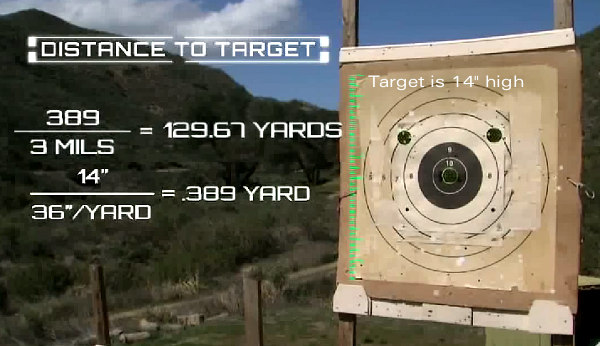How to Use Mil-Dot Scope Reticles to Estimate Range

MIL-system scopes are popular with tactical shooters. One advantage of MIL scopes is that the mil-dot divisions in the reticle can be used to estimate range to a target. If you know the actual size of a target, you can calculate the distance to the target relatively easily with a mil-based ranging reticle. Watch this helpful NRA video to see how this is done:
Milliradian Definition and Yardage Ranging Formula
“MIL” or “Milrad” is short-hand for Milliradian, a unit of angular measurement. The subtension of 1 mil equals 3.6 inches at 100 yards or 36 inches at 1,000 yards. (In metric units, 1 mil equals 10 centimeters at 100 meters or 1 meter at 1,000 meters.) Knowing this subtension and knowing the size of the target (or a reference object near the target) allows the distance to the target to be estimated with considerable accuracy. The formula used to calculate range (in yards) based on MIL measurement is:

For example, if a 14″ tall target spans 3 mils from top to bottom, the distance is 129.67 yards calculated as follows: 14/36 x 1000 = 389, then divided by 3 = 129.67. You can also use a different conversion to find distance in meters.
Can You Estimate Range with an MOA-Marked Reticle? Yes You Can…
Reader Josh offers this handy advice: “It worth noting that the ability to measure range is not unique to mil-based systems. A MIL is just another unit for measuring angles, and any angular measurement will work. Considering that just about everybody knows that 1 MOA is about an inch per hundred yards, similar formulae can be developed for ranging with MOA marks. The advantage with mils is the precise relationship between units — the MOA-inch measurement is imprecise (being off by 0.047″) — so in principle MILs are a better unit”.
Similar Posts:
- How to Range Targets with MIL-Reticle Optics
- How to Range Targets Using Reticle Markings in Milrad Scopes
- MIL vs. MOA — Angular Measurement Basics
- Angular Measurement — Mil vs. MOA — What You Need to Know
- MIL vs. MOA — Scope Angular Click Values Explained
Tags: Mil, Mil dot, Mildot, Milliradian, Milrad, NRA Science, Optic, Scope


















Ranging is pretty low on the list of things tactical shooters use the reticle for. The reticle is used primarily for wind hold-offs, hold-overs, hold-unders and leads on movers. This is why tactical shooters favor FFP scopes, they want to be able to do these things at any magnification.
It’s probably worth noting that the ability to measure range is not unique to mil-based systems. A mil is just another unit for measuring angles, and any angular measurement will work. Considering that just about everybody knows that 1 MOA is about an inch per hundred yards, similar formulae can be developed for ranging with MOA marks.
The advantage with mils is the precise relationship between units — the MOA-inch measurement is imprecise (being off by 4.7% or so) — so in principle mils are a better unit.
Yes, I just double checked: 1 Mil = 3.937″ @ 100 METERS. And 39.37″ @ 1000 METERS. NOT YARDS.
1 Mil = 3.6″ @ 100 YARDS… 36″ @ 1000 YARDS
What ever happened to RNG = (inches/dots) * 27.78? Much easier to type into a calculator or glance at a look up table for.
As for RNG’ing with a variable power SFP Scope – what’s the point? The moment you change the magnification away from the ‘default’ setting, its useless for RNG’ing. Not to mention the lack of confidence I’d have, just in case it got bumped or whatever.
If you’re RNG’ing with a Variable Power Scope, it HAS to be a FFP, as Kris pretty much said.
D
Since cheap Laser Range Finders came onto the market, this is school room stuff only. And 90% of hunting situations happen within 100 yards.
But as the first commentator said, the FFP stadia work supremely well for wind and holdover.